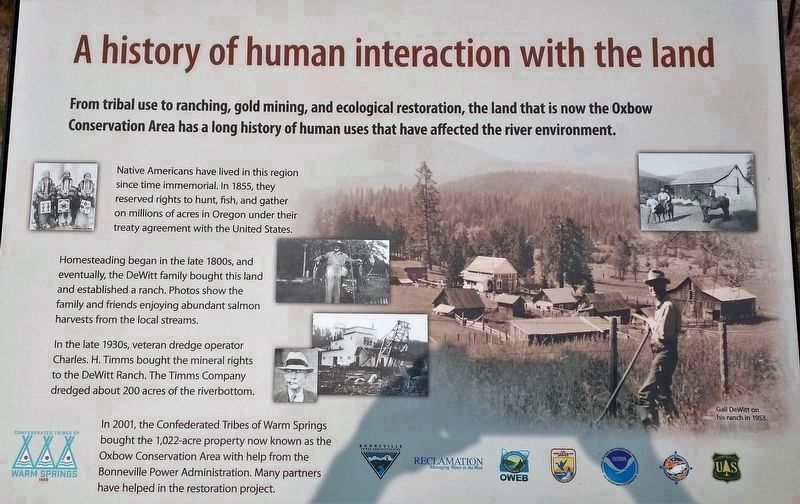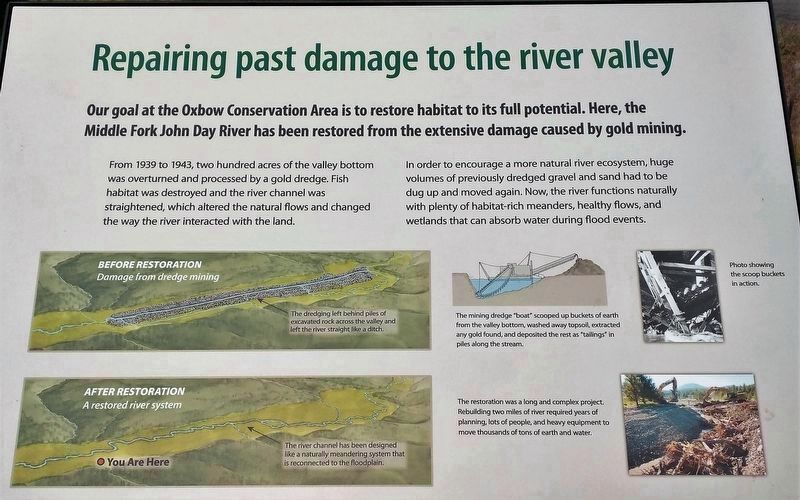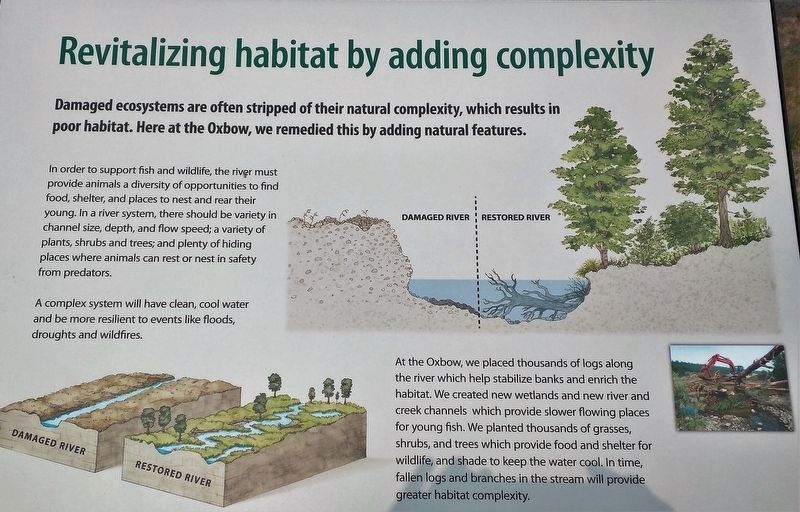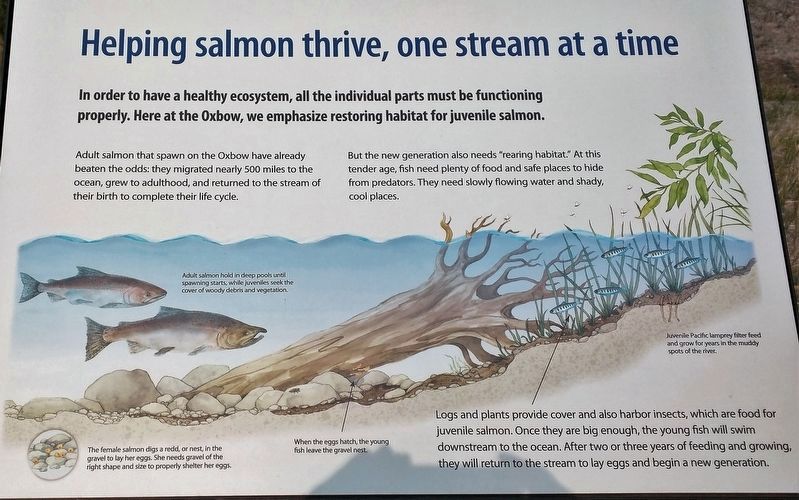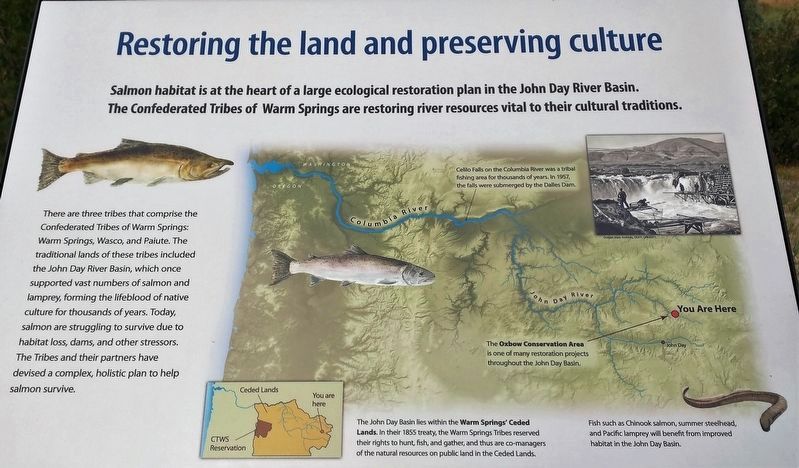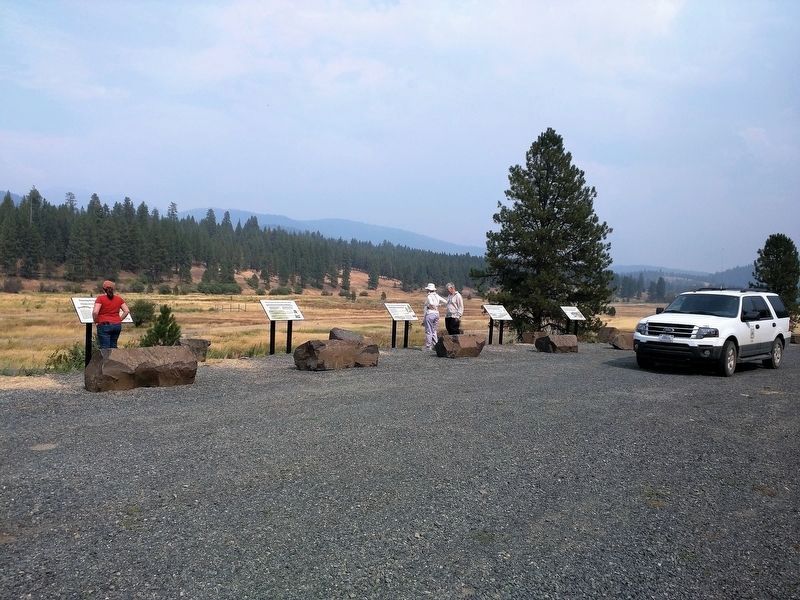Near Bates in Grant County, Oregon — The American West (Northwest)
The Oxbow Conservation Area
Inscription.
There are five markers describing the area
Marker 1:
A history of human interaction with the land
From tribal use to ranching, gold mining, and ecological restoration, the land that is now the Oxbow Conservation Area has a long history of human uses that have affected the river environment.
Native Americans have lived in this region since time immemorial. In 1855, they reserved rights to hunt, fish, and gather on millions of acres in Oregon under their treaty agreement with the United States.
Homesteading began in the late 1800s, and eventually, the DeWitt family bought this land and established a ranch. Photos show the family and friends enjoying the abundant salmon harvests from the local streams.
In the late 1930s, veteran dredge operator Charles H. Timms bought the mineral rights to the DeWitt ranch. The Timms Company dredged about 200 acres of the riverbottom.
In 2001 the Confederated Tribes of Warm Springs bought the 1,022 acre property now known as the Oxbow Conservation Area with help from the Bonneville Power Administration. Many partners have helped in the restoration project.
Marker 2:
Repairing past damage to the river valley
Our goal at the Oxbow Conservation Area is to restore habitat to its full potential. Here, the Middle Fork John Day River has been restored from the extensive damage caused by gold mining.
From 1939 to 1943, 200 acres of valley bottom was overturned and processed by a gold dredge. Fish habitat was destroyed and the river channel was straightened, which altered the natural flows and changed the way the river interacted with the land.
In order to encourage a more natural river ecosystem, huge volumes of previously dredged gravel and sand had to be dug up and moved again. Now, the river functions naturally with plenty of habitat rich meanders, healthy flows, and wetlands that can absorb water during flood events.
Marker 3:
Revitalizing habitat by adding complexity
Damaged ecosystems are often stripped of their natural complexity, which results in poor habitat. Here at the Oxbow, we remedied this by adding natural features.
In order to support fish and wildlife, the river must provide animals a diversity of opportunities to find food, shelter, and places to nest and rear their young. In a river system their should be a variety of channel size, depth, and flow speed; a variety of plants, shrubs and trees; and plenty of hiding places where animals can rest or nest in safety from predators.
A complex system will have clean, cool water and be more resilient to events like floods, droughts and wildfires.
At the Oxbow, we placed thousands of logs along the river which help stabilize the banks and enrich the habitat. We created new wetlands and new river and creek channels which provide slower flowing places for young fish. We planted thousands of grasses, shrubs, and trees which provide food and shelter for wildlife, and shade to keep the water cool. In time, fallen logs and branches in the stream will provide greater habitat complexity.
Marker 4:
Helping salmon thrive, one stream at a time.
In order to have a healthy ecosystem, all of the individual parts must be functioning properly. Here at the Oxbow, we emphasize restoring habitat for juvenile salmon.
Adult salmon that spawn on the Oxbow have already beaten the odds: they migrated nearly 500 miles to the ocean, grew to adulthood, and returned to the stream of their birth to complete their life cycle.
But the new generation also needs "rearing habitat." At this tender age fish need plenty of food and safe places to hide from predators. They need slowly flowing water and shady, cool places.
Logs and plants provide cover and also harbor insects, which are food for juvenile salmon. Once they are big enough, the young fish will swim downstream to the ocean. After two to three years of feeding and growing, they will return to the stream to lay eggs and begin a new generation.
Marker 5:
Restoring the land and preserving culture
Salmon habitat is at the heart of a large ecological restoration plan in the John Day River Basin. The Confederated Tribes of Warm Springs are restoring river resources vital to their cultural traditions.
There are three tribes that comprise the Confederated Tribes of Warm Springs: Warm Springs, Wasco and Paiute. The traditional lands of these tribes included the John Day River Basin, which once supported vast numbers of salmon and lamprey, forming the lifeblood of native culture for thousands of years. Today, salmon are struggling to survive due to habitat loss, dams, and other stressors. The tribes and their partners have devised a complex, holistic plan to help salmon survive.
Erected by Confederated Tribes of Warm Springs.
Topics. This historical marker is listed in these topic lists: Environment • Native Americans.
Location. 44° 39.003′ N, 118° 40.573′ W. Marker is near Bates, Oregon, in Grant County. Marker is on Up Middle Fork Road (County Highway 20), on the right when traveling west. These five markers are easily visible in a pullout at the side of the road. Touch for map. Marker is in this post office area: Bates OR 97817, United States of America. Touch for directions.
Other nearby markers. At least 3 other markers are within 14 miles of this marker, measured as the crow flies. Sumpter Valley Railroad Hiking Trail (approx. 8.7 miles away); The Fremont Powerhouse Historic District (approx. 13.4 miles away); Red Boy Mine (approx. 14 miles away).
Credits. This page was last revised on September 24, 2017. It was originally submitted on August 27, 2017, by Don Hann of Canyon City, Oregon. This page has been viewed 339 times since then and 25 times this year. Photos: 1, 2, 3, 4, 5, 6. submitted on August 27, 2017, by Don Hann of Canyon City, Oregon. • Syd Whittle was the editor who published this page.
